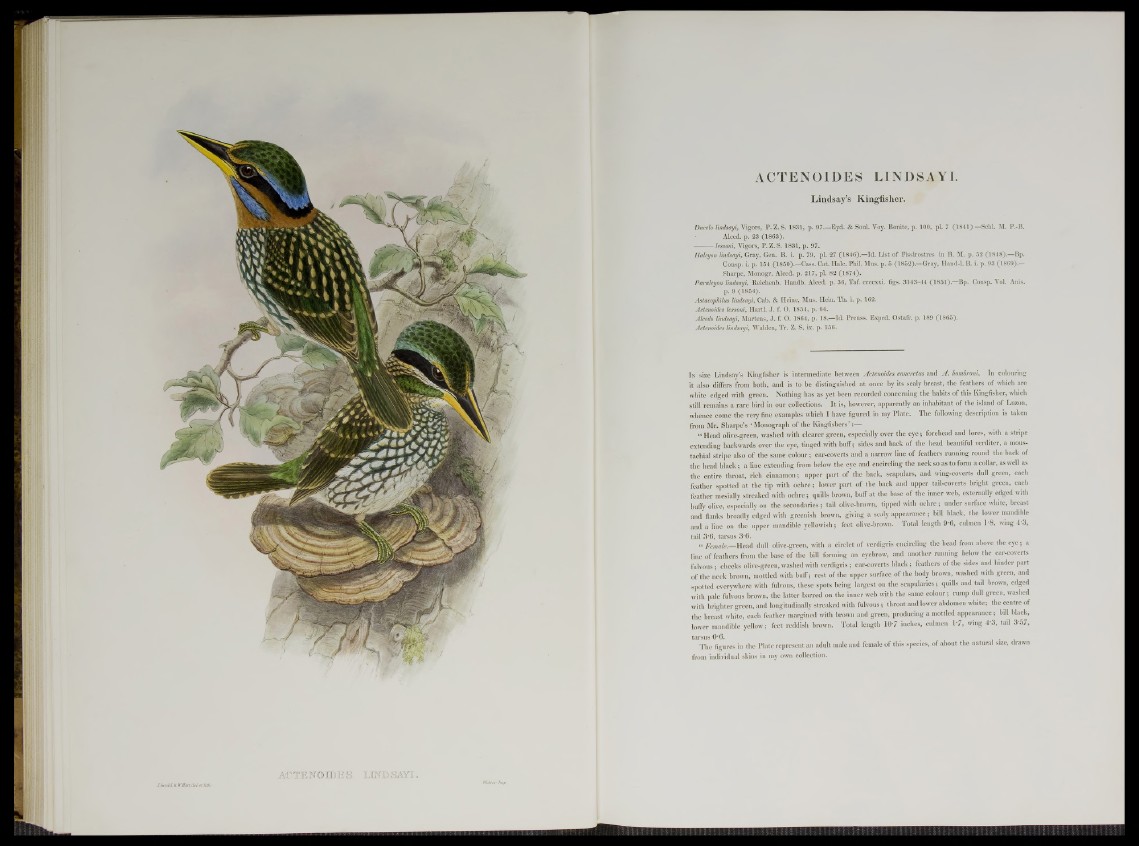
J.O uul/Lk W. IlarL dele e t lil/is.
.AC TE NO IME S LINBSÄYI.
W oher In
ACTENOIDES LINDSAYI .
Lindsay’s Kingfisher.
Itacelo Imäsayi, Vigors, P. Z. S. 1831, p. 97.—Eyd. & Soul. Voy. Bonite, p. 100, pi. 7 (1841) —Schl. M. P.-B.
Aleed. p. 23 (1863).
— lessoni, Vigors, P. Z. S. 1831, p. 97.
Halcyon lindsayi, Gray, Gen. B. i. p. 79, pi. 27 (1846).—Id. List of Fissirostres in B. M. p. 52 (1848).—Bp.
Consp. i. p. 154 (1850).—Cass. Cat. Hale. Phil. Mus. p. 5 (1852).—Gray, Hand-1. B. i. p. 93 (1869).—
Sharpe, Monogr. Alced. p. 217, pi. 82 (1874).
Paralcyon lindsayi, Reichenb. Handb. Alced. p. 36, Taf. ccccxxi. figs. 3143-44 (1851).—Bp. Consp. Vol. Anis,
p. 9 (1854).
Astacophilus lindsayi, Cab. & Heine, Mus. Hein. Th. i. p. 162.
Actenoides lessoni, Hartl. J . f. 0 . 1854, p. 64.
Alcedo lindsayi, Martens, J. f. 0 . 1864, p. 18.— Id. Preuss. Exped. Ostafr. p. 189 (1865).
Actenoides lindsayi, Walden, Tr. Z. S. ix. p. 156.
In size Lindsay’s Kingfisher is intermediate between Actenoides concretus and A. lombroni. In colouring
it also differs from both, and is to be distinguished at once by its scaly breast, the feathers of which are
white edged with green. Nothing has as yet been recorded concerning the habits of this Kingfisher, which
still remains a rare bird in our collections. It is, however, apparently an inhabitant of the island of Luzon,
whence come the very fine examples which I have figured in my Plate. The following description is taken
from Mr. Sharpe’s ‘ Monograph of the Kingfishers’ :—
“ Head olive-green, washed with clearer green, especially over the eye; forehead and lores, with a stripe
extending backwards over the eye, tinged with buff; sides and back of the head beautiful verditer, a mous-
taehial stripe also of the same colour; ear-coverts and a narrow line of feathers running round the back of
the head black; a line extending from below the eye and encircling the neck so as to form a collar, as well as
the entire throat, rich cinnamon; upper part of the back, scapulars, and wing-coverts dull green, each
feather spotted at the tip with ochre; lower part of the back and upper tail-coverts bright green, each
feather mesially streaked with ochre; quills brown, buff at the base of the inner web, externally edged with
buffy olive, especially on the secondaries; tail olive-brown, tipped with ochre; under surface white, breast
and flanks broadly edged with greenish brown, giving a scaly appearance; bill black, the lower mandible
and a line on the upper mandible yellowish; feet olive-brown. Total length 9• 6, culmen l -8, wing 4‘3,
tail 3-6, tarsus 3*6.
Female.—Head dull olive-green, with a circlet of verdigris encircling the head from above the eye; a
line of feathers from the base of the bill forming an eyebrow, and auother running below the ear-coverts
fulvous; cheeks olive-green, washed with verdigris; ear-coverts black; feathers of the sides and hinder part
of the neck brown, mottled with buff; rest of the upper surface of the body brown, washed with green, and
spotted everywhere with fulvous, these spots being largest on the scapularies; quills and tail brown, edged
with pale fulvous brown, the latter barred on the inner web with the same colour; rump dull green, washed
with brighter green, and longitudinally streaked with fulvous; throat and lower abdomen white; the centre of
the breast white, each feather margined with brown and green, producing a mottled appearance; bill black,
lower mandible yellow; feet reddish brown. Total length 10-7 inches, culmen 1 '7 , wing 4-3 , tail 3-57,
tarsus 0*6. > .
The figures in the Plate represent an adult male and female of this species, of about the natural size, drawn
from individual skins in my own collection.